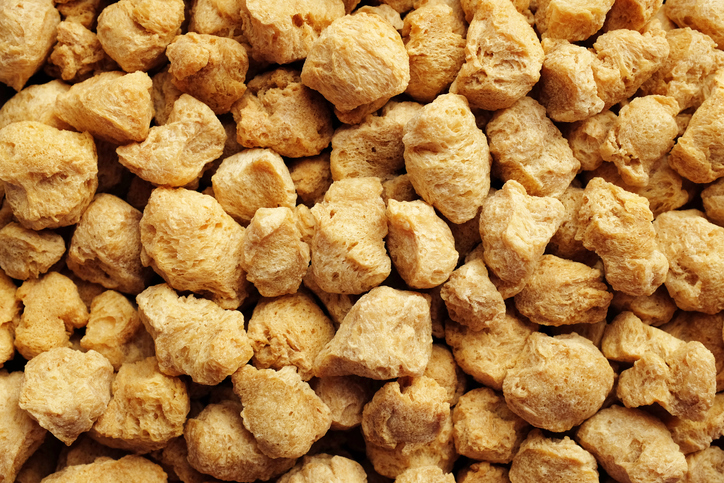THE NUTRITIONAL ROLE OF SOYA AS APPLICABLE TO MENOPAUSAL WOMEN

While the nutritional properties of soya in relation to the population as a whole are well known, there has been much debate and research into its role in the diet of menopausal women. The physiological and other changes occurring during menopause and the role of hormones in these changes have been extensively studied and in particular the role of estrogens, which are produced primarily in the ovaries and during pregnancy, but whose rate of production in the body diminishes significantly during menopause and are believed to be at least partially the cause of many of the clinical symptoms observed during menopause such as hot flushes, increased incidence of urinary tract infections, joint and muscle pain and behavioural problems such as mood swings as well as longer term effects such as loss of bone mass and the possible development of certain breast cancers known as hormone-sensitive cancers. High estrogen intakes have also been linked to increased risk of strokes.
Where soya comes into the picture here is because it contains substances known as isoflavones. These are naturally occurring organic compounds that possess similar structures and chemical characteristics to estrogens. Soya contains a number of different isoflavones but the most widely known ones are genistein and daidzein. Typical isoflavone content of dry soya beans is around 100 milligrams per 100 grams or about 0.1% by weight while products derived from soya such as tofu typically contain around 0.03% of isoflavones. In countries with high soya consumption such as Japan, intake of soya isoflavones could be between 15 and 50 milligrams per day.
Due to the similarities between isoflavones and estrogens, it has therefore been suggested that the consumption of soya products may help to offset some of the effects of the menopause. Isoflavones are absorbed into the body in largely the same manner as estrogens and bind to the so-called estrogen receptors in our bodies and can have some of the same hormonal effects as estrogens. Of particular interest is the observation that the binding of isoflavones may be tissue-selective, which mean isoflavones mimic the effects of estrogen in some tissues and blocks the effects of estrogen in others. The extent to which soy isoflavones exert estrogenic and anti-estrogenic effects in animals and humans is currently the focus of considerable scientific research.
There is a vast amount of information available on the effect of isoflavones on menopausal symptoms and it is not always easy to summarise this in simple terms. The sort of experiments that are conducted are usually clinical studies where a selection of people from within the group concerned (in this case menopausal women) consume controlled quantities of the substance concerned (in this case isoflavones) over a prolonged time period and the effects on a particular condition (for example bone mass) are assessed clinically by means of suitable quantitative measurements. The results are usually summarised in a paper which is reviewed by suitably qualified scientists and then published in a scientific journal. In the case of isoflavones and menopause, the results are often contradictory and confusing so we have a problem! A common technique when dealing with complex scientific issues of this sort is therefore to make use of what is known as a meta-analysis, which consists of a detailed review of results derived from a large number of different experiments by a group of scientists with specific experience in the subject under consideration, who then try to come to some broad based conclusions on the subject. Let’s look at the results obtained using this technique for some of the potential effects of isoflavones on medical symptoms typically observed in menopausal women.
Regarding the effect of isoflavones on hot flushes, two meta-analyses conducted by research groups in Australia and the UK found a slight to modest reduction in the number of these experienced by menopausal women when isoflavones were deliberately added to their diets. Both summaries were based on the outcomes of 17 different clinical studies.
Regarding the effect of isoflavones on bone density, one meta-analysis conducted in Japan covering 28 different studies on bone mineral density (which is a measure of bone mass and strength) in the spine, femoral and hipbones of menopausal women showed an improvement in bone density in the spine but no significant effects on the other bones. This was confirmed in a meta-analysis conducted in China in 2008. A further meta-analysis conducted in China in 2008 however showed no significant beneficial effect on bone density in the spine or hip.
Regarding the effect of isoflavones on cholesterol levels, a meta-analysis conducted in Japan incorporating 8 different studies indicated a clearly beneficial effect of isoflavones in lowering LDL cholesterol.
Regarding breast cancer, a meta-analysis conducted in China in 2011, which considered 18 different studies, concluded that isoflavone consumption appeared to have a beneficial effect in reducing the risk of breast cancer incidence in Asian populations but this was not observed in Western populations.
What can we conclude from these unfortunately rather complicated and sometimes contradictory findings? It does appear that in some (but, importantly, not necessarily all) instances the consumption of isoflavones, either directly as supplements or indirectly via the consumption of soya products, can have a beneficial effect on a number of the symptoms associated with the menopause. However neither the isoflavones themselves nor soya products as a whole should be regarded as an instant solution to the very real problems experienced by menopausal women in terms of either day-to-day symptoms or longer term effects on their health. Certainly there is no harm in menopausal women moderately increasing their consumption of soya products as prolonged consumption may well be beneficial. However to expect overnight results is simply not realistic and any woman suffering from menopausal symptoms should consult with their doctor before embarking on any significant increase in their consumption of soya products.
Nigel Sunley
Sunley Consulting
27/4/2014